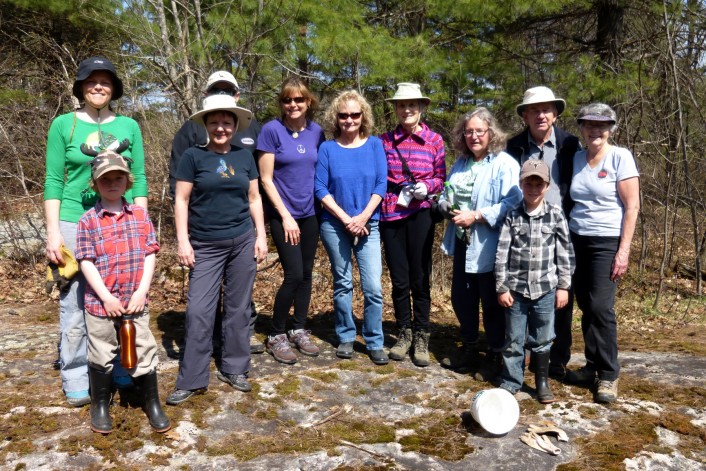With involvement in more than 40 natural properties and a very small paid staff, The Couchiching Conservancy would be in a tough spot if not for a small army of dedicated volunteers.
Many of those volunteers make up property teams which help us look after the lands under our care.
One of these teams was in action recently at Alexander Hope Smith Nature Reserve, offering a great example of the kind of work accomplished with spirited leadership and a passion for the natural landscape.
Washago resident Cathy Massig is the long-time leader of the Hope Smith property team and she has been a go-to volunteer for many years now. The team acts as eyes and ears on the property, watching for any changes that might spell trouble for the forest. There is an unfortunate tendency among some people to treat vacant land as a dumping ground, and conservation properties sometimes suffer the abuse of abandoned mattresses and bags of garbage deposited along roadsides. Roofing shingles are also occasionally dumped. Property team members keep an eye out for this kind of abuse and promptly report it when it occurs. They also help us install and maintain trails, bridges, signage and such.
While doing regular visits to the property, the team also keeps watch for interesting plants and animals which, when identified, can be added to the inventory lists the Conservancy keeps for each property. In recent years, invasive species have become an increasing problem in some of the relatively pristine habitats protected by the Conservancy, and again, property teams take a central role in helping us maintain native biodiversity.
Recently the Alexander Hope Smith team tackled an infestation of garlic mustard on the property. Garlic mustard was accidentally introduced to Ontario woodlands by gardeners who enjoy this prolific herb. It makes a good salad, but it’s hell on the understory of a forest. The plant is fascinating in that it not only beats out most of the native plants that grow on Ontario forest floors, but it also changes the chemical composition of the soil to weaken trees and open up the forest canopy. With more sunlight comes more garlic mustard.
With no predators, it’s currently a picnic in the woods for this plant, and the fear is that unchecked it will radically alter forests already under extreme stress.
Following a careful disposal system, the team pulled garlic mustard by hand. This is a tough job and it must be done repeatedly over many years because once garlic mustard sets seeds, they can survive in the soil for up to seven years. Volunteers have to return to the site year after year, pulling new plants before they flower. This is often frustrating work, but we have recently begun to see the effects of multiple years of work on two other heavily infested properties. Our hope is to maintain islands of biodiversity on these conservation properties until native species have adapted to the presence of garlic mustard and some balance is restored.
Without hard-working volunteers like the Alexander Hope Smith property team, this task simply wouldn’t be possible.
Written by Executive Director Mark Bisset.

